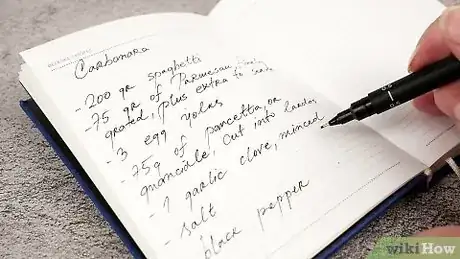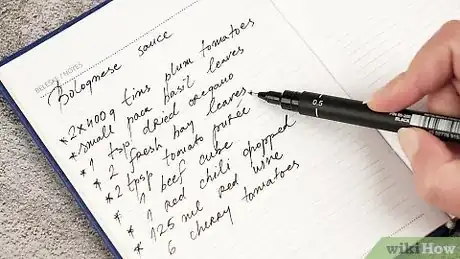This article was co-authored by wikiHow staff writer, Amber Crain. Amber Crain has been a member of wikiHow’s writing staff for the last six years. She graduated from the University of Houston where she majored in Classical Studies and minored in Painting. Before coming to wikiHow, she worked in a variety of industries including marketing, education, and music journalism. She's been a radio DJ for 10+ years and currently DJs a biweekly music program on the award-winning internet radio station DKFM. Her work at wikiHow supports her lifelong passion for learning and her belief that knowledge belongs to anyone who desires to seek it.
There are 7 references cited in this article, which can be found at the bottom of the page.
The wikiHow Video Team also followed the article's instructions and verified that they work.
This article has been viewed 399,723 times.
Learn more...
Simmering is an essential technique that every cook needs to master. It isn’t difficult to learn, but it does take a little practice. Recipes will often mention simmering in some capacity, but they don’t always explain what it means or how to do it. Simmering means to cook a liquid at a temperature that is slightly under the boiling point. It’s a gentle way to gradually cook ingredients until they are tender. It also preserves and intensifies flavors by concentrating them. There are several key ways to identify when a liquid is simmering. Once you know what to look for, you will have no problem mastering this technique.
Steps
Identifying the Stages of Simmering
-
1Read the recipe closely.[1] In most cases, a recipe will suggest one of two ways to do it. It may ask you to bring the liquid of a dish to a simmer, which means to slowly bring the liquid to just below boiling point over low heat. The other common direction is to bring the liquid of a dish to the boiling point first, and then reduce it to a simmer. The two techniques yield different results, so it’s important to practice them properly.[2]
To simmer means to bring a liquid to a temperature that is just below the boiling point – somewhere between 185°F (85°C) and 205°F (96°C).[3]
-
2Set the heat to medium-low for a gradual simmer.[4] Place the dish you're cooking on the burner and start off at a medium to low heat. Stay near the stovetop, since you will probably need to adjust the heat up or down as the liquid is brought up to a simmer. It’s a good rule of thumb to never turn your back on a simmer in progress until you’re sure you’ve reached a point of constant simmering.
- Experiment with a pot of water if you want to practice first.
- Try out different heat settings to get a feel for how the cooking liquid appears at different temperatures.
Advertisement -
3Observe the amount of bubbles rising to the surface. You know something is simmering when there are pockets of tiny, continuous bubbles breaking the surface with irregular wisps of steam. Simmering is most commonly used to allow the flavors of a dish to infuse and to slow-cook meats until they are tender.
- A “slow simmer” is when a couple of tiny bubbles erupt every 1 or 2 seconds. A slow simmer is most often used to slow-cook stocks.
- A “rapid simmer” happens when larger pockets of small, continuous bubbles erupt at the surface, displaying wisps of steam, with larger bubbles beginning to show.
- A rapid simmer is sometimes referred to as a gentle boil; it's mostly used to thicken liquid into sauce.[5]
-
4Test for a temperature between 185°F (85°C) and 205°F (96°C) . If you have a cooking thermometer, you can always test the liquid to find out if you’ve achieved a simmer. Most people don’t use a thermometer – they gauge by observation. You'll get more experienced at this as you go along.
- Temperatures between 185°F (85°C) and 205°F (96°C) are considered simmering.
- The range is relatively high because there are different levels of simmering, starting with a slow simmer and going up to a rapid simmer.[6]
-
5Regulate the heat to maintain a constant simmer.[7] Once you've reached the simmering point, you will need to adjust the heat between medium-low and low to maintain a constant simmer. Slightly adjust the heat up or down as needed. Once you’ve achieved a steady simmer, you will still need to stir the liquid occasionally.
- Whenever you introduce new ingredients to simmering liquid, the heat will definitely need to be adjusted.
- Some liquids and sauces require more frequent stirring than others. Check your recipe for details.
- Stay at your stove to supervise during this initial stage until you get a feel for how often it needs to be stirred.
Simmering and Reducing a Sauce
-
1Follow the recipe instructions to start the sauce. Many recipes will ask you to make the sauce’s foundation and then simmer it for a certain amount of time. This will “reduce” the sauce. Essentially, this means to thicken the sauce’s consistency. When you reduce a sauce, the ingredients develop through a period of simmering into a thicker, richer, more flavorful substance.[8]
- The longer you simmer the sauce, the thicker it will become and the more it will “reduce.”[9]
- The most commonly reduced sauces are tomato sauce, Béchamel sauce, balsamic reduction sauce, red wine reduction sauce and most sauces that begin with meat drippings.[10]
- White sauces typically aren't reduced.
-
2Reduce the heat to low. Once you’ve created the foundation of your sauce, reduce the heat to low to bring it down to a simmer. You’ve reached a “simmer” when you see tiny, continuous bubbles breaking the surface of the sauce. You’ll also see irregular wisps of steam rise up from the sauce. As you’re bringing your sauce down to a simmer, stir it frequently.[11]
- It’s best to stay with the sauce at least until a steady simmer is achieved.
- Avoid turning your back to do something else at this stage. Keep an eye on the sauce.
-
3Regulate the heat and stir occasionally. You may need to adjust the heat between medium-low and low to maintain simmering for an extended period of time. Once you’ve achieved a steady simmer, you can leave the sauce alone for longer periods of time without too much worry. You do need to return to the sauce to stir it occasionally. Regulating the heat properly and frequent stirring helps to prevent a sauce form getting burned. Keep a close eye on this.
- If it does burn and you don't notice, you'll end up stirring charred bits from the bottom of the pan into your sauce.
- Avoid scraping anything against the bottom of the pan if you've burned the sauce.
- Some sauces need more frequent stirring than others, so stay with your sauce for a while until you get a feel for how much stirring is required.
- Regulate the heat as needed to maintain the simmer.[12]
-
4Simmer the sauce until the desired consistency is acquired. Some recipes will give you specific directions how long something needs to simmer. Others will tell you to simmer until you’ve reached the thickness you want. Many sauces can be simmered for hours, gradually growing thicker and more flavorful over time. Italian tomato sauce is a great example of a sauce that can be simmered over a period of hours to “reduce” it.
- The longer the sauce is simmered, the thicker and more “reduced” it becomes. The flavors become infused and rich.
- As long as you stir your sauce occasionally and maintain a steady simmer by regulating the temperature, your reduction will go smoothly.[13]
Simmering Meats
-
1Spread vegetable oil all over the meat. Instead of coating the skillet with vegetable oil, coat the pieces of meat with it. You will actually end up using less oil that way, so it’s a more heart-healthy approach. The meat will brown better, as well. In general, the ideal cuts of meat for this are tough and inexpensive. When simmered over time, they become tender.
- This approach works best for red meats like beef and lamb.
- If you’re working from a recipe, make sure to reference those directions frequently.
-
2Brown the meat in a skillet over medium high-heat. A cast-iron skillet is the best choice for this. Place the oil-coated pieces of meat into a medium-sized skillet over medium-high heat. Instead of putting all the meat in at once, brown the pieces in small batches.
- Use a utensil to move the meat around frequently so that it browns evenly.
- Remove each batch after browning.
- Put the browned meat on a clean plate and set it to the side.
-
3Pour the liquid in the skillet and bring it to a boil. After browning all of the meat and removing it from the skillet, pour in your cooking liquid. Depending on that you’re cooking, this will be some kind of stock or possibly wine. The heat should remain at a medium-high level until the liquid has reached a rolling boil.[14]
- You know it’s boiling when bubbles are vigorously breaking on the surface and the liquid is moving and churning in the skillet.[15]
-
4Reduce the heat to low to bring it to a simmer. Once you’ve reached the boiling point, lower the heat to bring the liquid down to a simmer. You’ll know it’s simmering when you see pockets of tiny, continuous bubbles breaking the surface, along with irregular wisps of steam.
- The liquid should be at the simmering point before you add the meat back to the skillet.
- Adding the meat to a simmering liquid will help it be as tender as possible.
-
5Put the browned meat back into the skillet. Once you’ve reached the simmer point, carefully add the pieces of meat back into the skillet. Regulate the heat as necessary and stir occasionally. You’ll probably need to adjust the heat between medium-low and low to maintain simmering.
- These basic guidelines are universal to get the simmer process started for most meats.
- The simmer time depends on the type of meat and what you’re making.
Community Q&A
-
QuestionDo I put the lid on when simmering a pot of soup?
 Community AnswerThe lid is usually put on, in order to reduce the amount of water that evaporates during the simmering process.
Community AnswerThe lid is usually put on, in order to reduce the amount of water that evaporates during the simmering process. -
QuestionHow do I simmer tough cuts of meat or old fowl?
 Community AnswerBrown the meat first, then remove from the skillet. Pour in your broth, bring it to a boil, then reduce to a simmer. Put the browned meat back into the skillet and allow it to simmer in the broth for a specific amount of time until it becomes tender. The length of time depends on the kind of meat you're using and the dish you're making.
Community AnswerBrown the meat first, then remove from the skillet. Pour in your broth, bring it to a boil, then reduce to a simmer. Put the browned meat back into the skillet and allow it to simmer in the broth for a specific amount of time until it becomes tender. The length of time depends on the kind of meat you're using and the dish you're making.
References
- ↑ http://www.thekitchn.com/cooking-school-day-15-simmer-the-kitchns-cooking-school-211021
- ↑ http://www.cookinglight.com/cooking-101/techniques/cooking-class-boiling-and-simmering
- ↑ https://www.britannica.com/topic/boiling-cooking
- ↑ http://www.thekitchn.com/cooking-school-day-15-simmer-the-kitchns-cooking-school-211021
- ↑ http://www.finecooking.com/item/44515/whats-the-difference-between-a-simmer-and-a-boil
- ↑ http://www.finecooking.com/item/44515/whats-the-difference-between-a-simmer-and-a-boil
- ↑ http://www.cookinglight.com/cooking-101/techniques/cooking-class-boiling-and-simmering
- ↑ http://www.thekitchn.com/cooking-school-day-15-simmer-the-kitchns-cooking-school-211021
- ↑ http://www.cookinglight.com/cooking-101/techniques/cooking-class-boiling-and-simmering
- ↑ https://www.thekitchn.com/technique-making-a-sauce-reduc-66604
- ↑ http://www.finecooking.com/item/44515/whats-the-difference-between-a-simmer-and-a-boil
- ↑ http://www.cookinglight.com/cooking-101/techniques/cooking-class-boiling-and-simmering
- ↑ http://www.cookinglight.com/cooking-101/techniques/cooking-class-boiling-and-simmering
- ↑ http://www.thekitchn.com/cooking-school-day-15-simmer-the-kitchns-cooking-school-211021
- ↑ http://www.cookinglight.com/cooking-101/techniques/cooking-class-boiling-and-simmering
- Videos provided by Cooking Light
About This Article
Simmering is an essential cooking skill. To simmer a liquid, such as a broth or sauce, put it in a pot on the stovetop and set the heat to medium-low. After a few minutes, you should start to notice bubbles rising to the surface of the liquid. If your recipe calls for a slow simmer, aim for a few small bubbles every 1-2 seconds. For a rapid simmer, also known as a slow boil, look out for a continuous stream of small bubbles that release steam when they pop. If you have a cooking thermometer, check for a temperature of around 185-205° F (85-96° C). Turn the heat down if your liquid starts bubbling too fast, and turn it up a little if it stops simmering. You’ll probably need to adjust the heat any time you add new ingredients to the mix.


























































